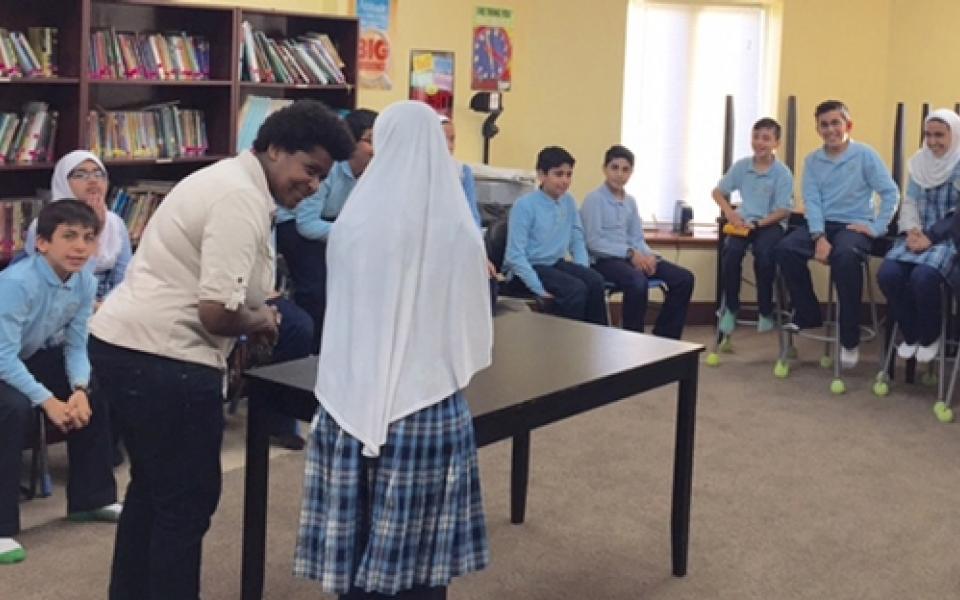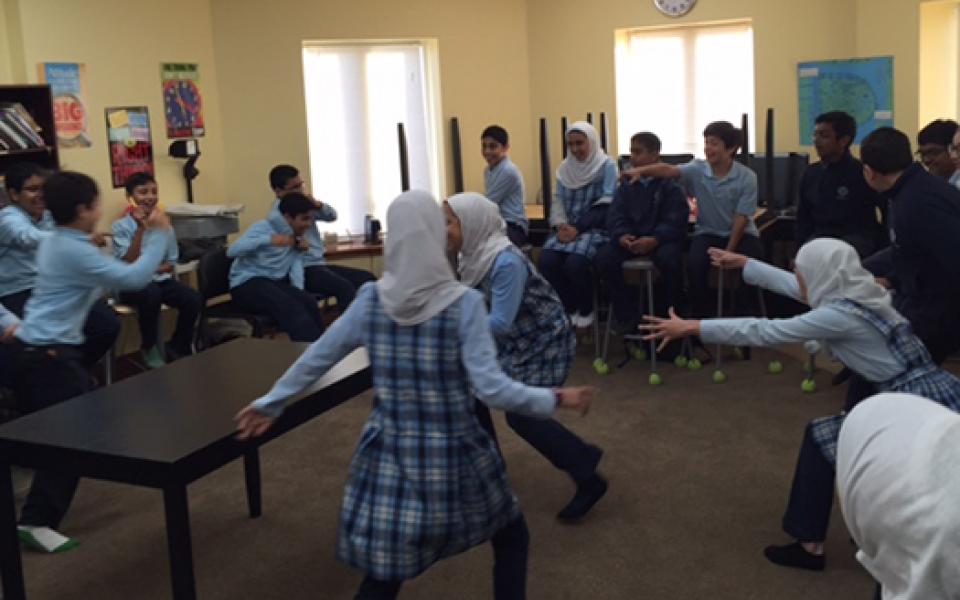
Sally Mahé, Dom Gelin and I had the pleasure of visiting middle schoolers at Peace Terrace Academy in Fremont, California, a Pre-K through 8th grade Islamic school in the East Bay. The morning greeted us with a variety of treats including the beautifully still sunrise on our drive over, the stunning but simple white domes of Peace Terrace school and moms and dads bustling in and out of the parking lot to drop the kids off at school. Upon entering the school we were met by usual elementary school sounds, the loud chatter of kids excitedly meeting on a Friday morning, as well as the less familiar beauty of middle schoolers reciting the Qur’an while seated casually on the floor of a classroom hovering over the holy text.
When we entered the classroom, all of the students were seated in a circle, girls in one row, boys in another. They held prayer cards which they recited in unison. While they seemed almost bored at the routine recitation, I felt a deep calm as I let the unified Arabic prayer sung by the nearly 30 middle schoolers sweep over me. What was for them probably a basic daily routine was such a treat for us visitors.

We began our visit with some brief introductions of ourselves and of URI. We are a bridge-building network, we emphasized. We focus on bringing people together and transforming conflict. And while this message is easily spoken, it is more difficult in practice. This is exactly why our time with the students was spent practicing the Principles of the URI rather than preaching them.
From our seats in the circle we came to know each other’s similarities and differences through an energizing game: "A Warm Wind Blows." In this game, one student stands at the center of the circle and says, “A warm wind blows….” followed by a self-descriptor, after which any student who also identifies with that descriptor must change their seat as fast as possible so as to not be the last person in the center of the circle. The self-identifier that evoked the most students to jump up from their seat and run across the room: “A warm wind blows for anyone who has a parent born in another country.”
The energy of middle schoolers dashing across the room and giggling could well have been an end in itself, what great morning fun! At the close of the game, we reflected on the fact that we share things in common and have differences, and much like a Cooperation Circle, it is important to take the time to learn about each others’ similarities and differences in a safe, inquisitive and accepting manner.

In a circle, we moved on to discuss some of the challenges and barriers to peace that we face in our communities. Some of the challenges the students named included: racism, socio-economic differences, language, educational differences, and gender. We then set out to find tangible solutions to these challenges, since, rather than thinking of the challenges we face as ends in themselves, we ought to think of them as opportunities to bridge the differences that cause conflicts. Some of the students’ ideas for conflict transformation included: Start a club to learn about each others’ traditions, help friends from other traditions celebrate their holy days, learn different languages, improve education access, stand up to bullies, and treat everyone like a friend.
We left the students with the sheets of ideas they generated, reminding them that they are capable of acting on the solutions they brainstormed. In the end we spoke with the gracious principal, Homaira Wassel, about the possibility of forming a Cooperation Circle of middle schoolers, since just next door to the school is a church where there is a joint preschool for Christian and Muslim children.
It was such a joy to visit the middle schoolers. They have such energy and creativity and unique outlooks on the world. I hope we get the chance to visit them again to mutually inspire one another to do the best we can to transform the barriers in our communities into opportunities for peace.
